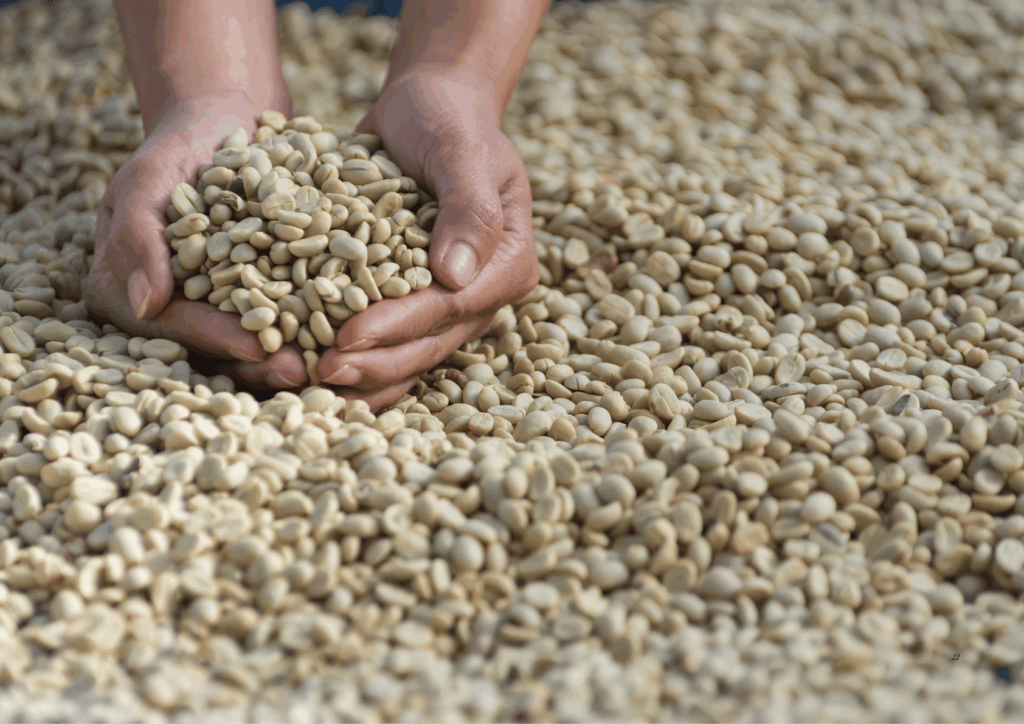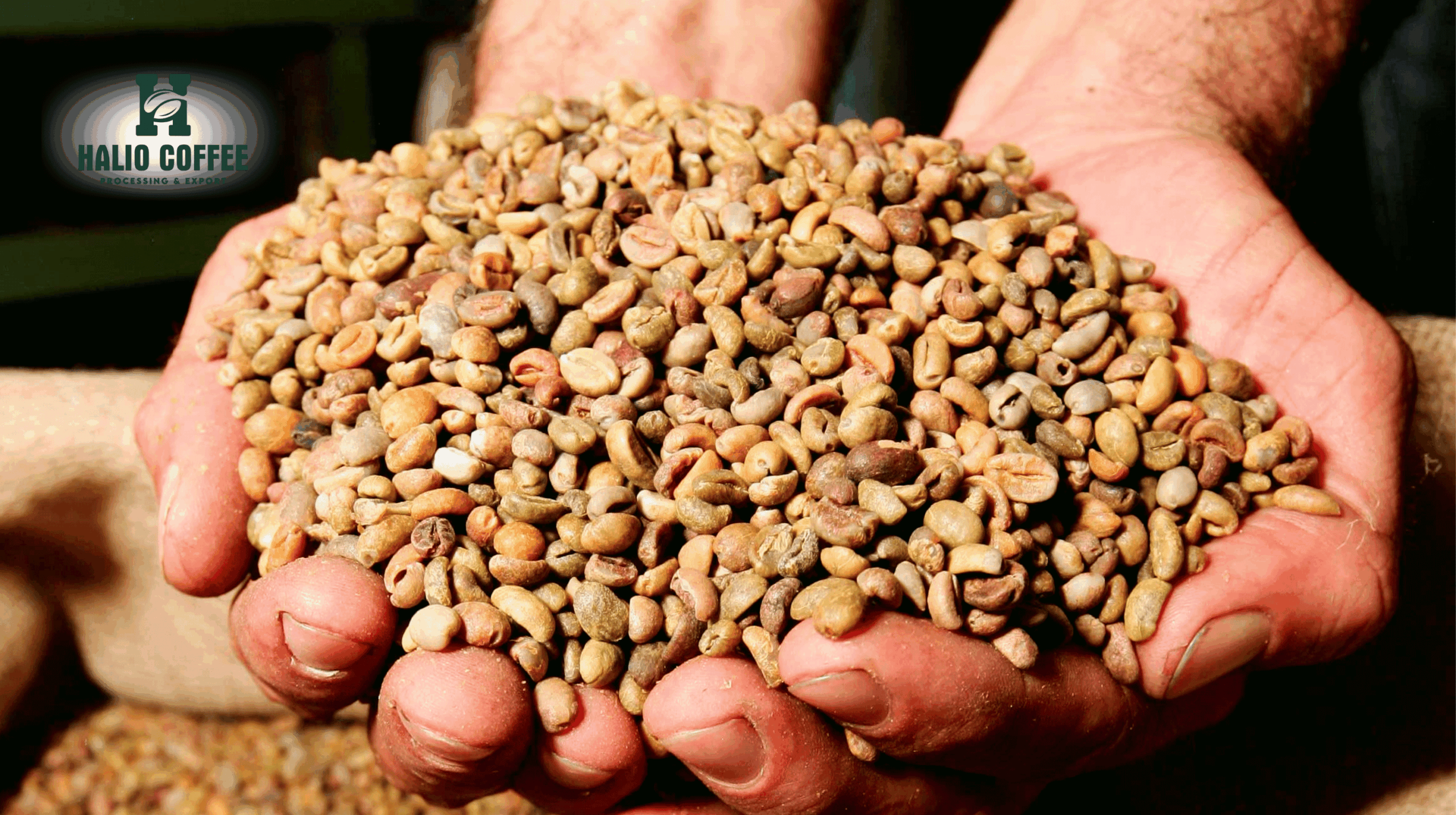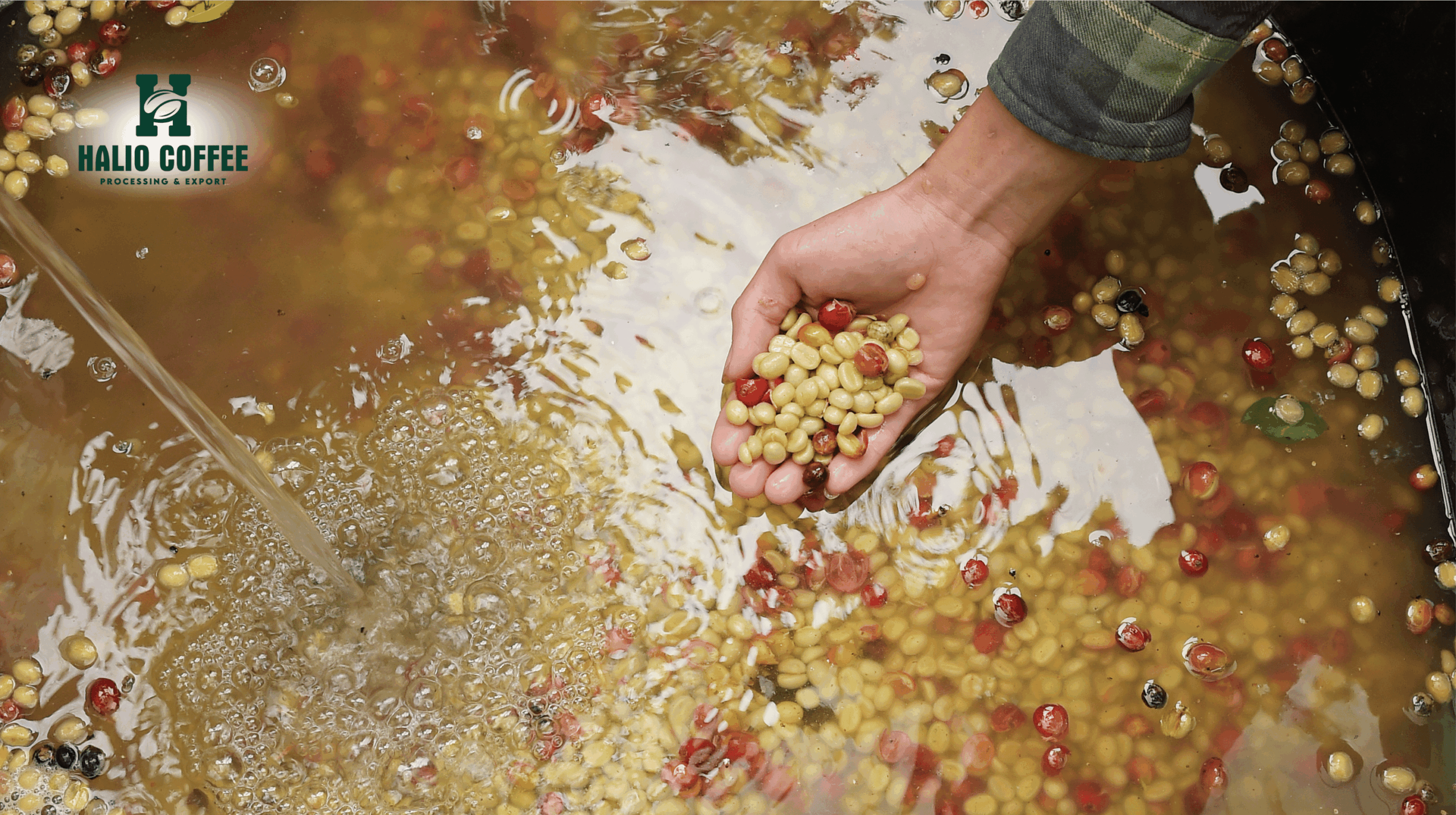Unroasted Robusta Coffee Beans
Unroasted Robusta coffee beans, also known as green Robusta coffee beans, are the most crucial raw material in the global coffee industry, especially for Vietnam – the world’s largest producer and exporter of Robusta. A thorough understanding of this bean type is key for every roaster, importer, and even the farmer.
1. Introduction to Unroasted Robusta Coffee Beans
Unroasted Robusta coffee beans are coffee beans that have been separated from the coffee cherry, cleaned, and dried, making them ready for the roasting process. They typically range from light green to dark green, depending on the processing method and freshness.
Key characteristics of unroasted Robusta beans:
- Shape: Usually rounder, smaller, and with a straighter central groove compared to Arabica beans.
- Color: Greenish-yellow or darker green than Arabica.
- Caffeine Content: Naturally high, which is its most prominent feature.
- Hardness: Robusta beans are generally harder and denser than Arabica beans.
- Potential Flavor: While they don’t have a distinct aroma like roasted coffee, high-quality unroasted Robusta beans can have a fresh, nutty, cereal, or slightly earthy smell. Low-quality beans might have pungent, moldy, or rubbery odors.
2. The Production Process of Unroasted Robusta Beans (From Farm to Warehouse)

This process profoundly impacts the final quality of the Robusta beans:
- Cultivation and Harvesting:
- Cultivation: Robusta plants adapt well to hot, humid climates with ample rainfall and are more resistant to pests and diseases. Most Robusta coffee in Vietnam is grown in the Central Highlands, particularly Dak Lak.
- Harvesting: In Vietnam, manual harvesting (picking ripe cherries) is increasingly encouraged to improve quality. However, stripping (harvesting all cherries from a branch at once) remains common to maximize yield.
- Processing: This is the most critical stage influencing the final flavor and quality of the bean.
- Natural/Dry Process: The most common method for Robusta in Vietnam. Coffee cherries are sun-dried whole on patios, mats, or raised beds until they reach the required moisture content. Afterward, the dried outer layers and pulp are removed. This method can yield bold flavors and a strong body, but if not well-controlled, it can lead to off-flavors (moldy, over-fermented).
- Washed Process: Less common for Robusta but gradually being adopted to produce cleaner, fewer-defect beans with clearer flavors. Coffee cherries are pulped fresh, then the beans are fermented in water to remove the mucilage layer before drying.
- Pulped Natural/Honey Process: Coffee cherries are pulped, but some mucilage is left on the beans during drying. This method can result in better sweetness and body for Robusta.
- Grading & Sorting: After processing, coffee beans are sorted by size, density, and defects (black beans, broken beans, insect-damaged, foreign matter) using machinery and manual labor.
- Packaging & Storage: Green coffee beans are typically packed in jute bags or GrainPro bags (specialized moisture-proof and freshness-preserving bags) and stored in dry, well-ventilated warehouses, away from direct sunlight and foreign odors, to maintain quality before export.
3. Factors Affecting the Quality of Unroasted Robusta Beans

For roasters and importers, assessing the quality of unroasted Robusta beans is critically important:
- Defect Rate: This is the most crucial criterion, measuring the number of defective beans in a given sample (e.g., 300g). The lower the defect rate, the higher the quality. Common defects include black beans, broken beans, unripe beans, insect bites, stones, and twigs.
- Moisture Content: Ideally 11% – 12.5%. Too high moisture (prone to mold, spoilage during transit/storage) or too low moisture (brittle, easily broken, affecting roasting) are both undesirable.
- Color and Freshness: Uniform, bright green beans are a sign of freshness. Yellowish or brownish beans may be old or poorly stored.
- Screen Size: Uniform bean size optimizes and evens out the roasting process.
- Green Bean Aroma: The aroma of unroasted beans can offer clues about quality. Good beans have a clean, fresh, nutty aroma. Beans with moldy, sour, or rubbery smells indicate poor quality.
- Traceability: Increasingly demanded by the market, especially with new regulations like the EUDR (EU Deforestation Regulation). Knowing the origin from the farm helps ensure sustainability and quality.
- Certifications: Organic, Fair Trade, Rainforest Alliance, 4C, UTZ Certified are important certifications that guarantee sustainable production processes and a certain level of quality.
See more:
- Robusta Coffee for Roasters
- Robusta Coffee Beans Bulk Buy
- Halio Coffee – Your Trusted Fresh Coffee Distributor of Robusta & Arabica Beans
4. Applications of Unroasted Robusta Beans in the Coffee Industry
- Espresso Blends: Robusta is an indispensable component in many traditional espresso blends, helping to create thick crema, a strong body, and high caffeine content.
- Instant Coffee: It’s the primary raw material due to its high soluble solids content, optimizing production efficiency.
- Ground Coffee: Widely used in traditional pour-over coffee (especially in Vietnam) or pre-ground packaged coffee blends.
- Specialty Robusta: An emerging segment where Robusta is carefully cultivated and processed to yield complex flavors, less harsh bitterness, suitable for single-origin use or in premium blends.
- Cold Brew: Robusta provides high body and caffeine for cold brew, creating a potent beverage.
5. Vietnam’s Role in the Unroasted Robusta Bean Market
Vietnam plays a pivotal role in the global Robusta supply chain:
- Largest Supplier: Accounts for over 50% of global Robusta production.
- Improving Quality: While once known for bulk production, the quality of Vietnamese Robusta is significantly improving thanks to farmer support programs, adoption of sustainable farming techniques, and more advanced processing methods (like washed and honey processing).
- Potential for Specialty Robusta Development: Regions like Buon Ma Thuot (Dak Lak) are at the forefront of developing high-quality Robusta with distinct flavor profiles, attracting attention from the international specialty coffee market.
- Sustainability and Traceability Challenges: To maintain and expand market share, Vietnamese exporters and farmers need to continue efforts in meeting increasingly high environmental and social standards from major import markets.
6. Advice for Buyers and Roasters
When sourcing unroasted Robusta beans, consider the following factors:
- Determine the intended use: Do you need Robusta for an espresso blend, instant coffee, or a specialty coffee? The purpose will dictate the quality requirements.
- Seek reputable suppliers: Prioritize suppliers with clear records of origin, robust quality control processes, and relevant certifications.
- Request samples and perform cupping: This is an indispensable step to evaluate the potential flavor and determine if the beans match your desired roasting profile and final product.
- Check quality metrics: Always verify the defect rate, moisture content, and screen size.
- Understand the processing method: The processing method significantly influences flavor. Washed Robusta might be cleaner, while natural-processed might be bolder.
- Consider sustainability certifications: This is not only good for the planet but also meets the demands of modern consumers.
Conclusion:
Unroasted Robusta coffee beans are fundamental to the diversity and growth of the coffee industry. Despite having distinct characteristics compared to Arabica, high-quality Robusta is increasingly being appreciated and plays a significant role in many premium coffee products. Vietnam, as a key player in Robusta production, continues its efforts to enhance the quality and sustainability of unroasted Robusta beans, meeting the increasingly complex and demanding needs of the global coffee market.
- Identifying the Critical Red Flags When Choosing a Coffee Supplier in Vietnam
- How to Brew Coffee Beans: Insights from Vietnam and the Global Coffee Industry
- Coffee Prices Today, September 24: Sharp Decline on Hopes of U.S.-Brazil Trade Talks
- The Definitive Market Map: An Analysis of the Top Green Coffee Exporters in Vietnam
- Coffee Prices Today, August 30: Rally Resumes as Speculators Drive Buying







